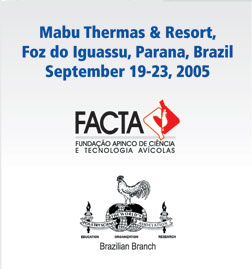LONG TERM VIABILITY
OF CRYOPRESERVED Eimeria SPOROCYSTS
R. M. Poston, L. K. Griffin,
C. Heggen-Peay, J. E. Hutchins, A. Martin, and
V. W. Doelling
Embrex, Inc., P.O. Box 13989, Research Triangle Park,
NC 27709
rposton@embrex.com
As Eimeria
oocysts have limited viability and cannot be effectively
cryopreserved, sporocysts from individual Eimeria
strains are the desired life stage for cryopreservation.
However, little data are available in the literature
indicating the effects of long-term frozen storage
on the viability of different Eimeria strains. Our
laboratory has used standard sporocyst preparation
and cryopreservation techniques on several Eimeria
strains including E. acervulina, E. maxima, and E.
tenella. After freezing, sporocysts were held in the
vapor phase of liquid nitrogen for long-term storage
prior to testing. To determine viability of the frozen
stock cultures, sporocysts were thawed, washed one
time, and administered by oral gavage to broiler chickens
at one of two doses. Fecal material from inoculated
birds was collected during the appropriate patent
period and oocyst output per bird determined. All
species tested were viable after three years and oocyst
output trended with sporocyst dosage used for gavage.
Oocyst output data from sporocysts stored for three
months in the vapor phase of liquid nitrogen were
comparable to oocyst output from stocks frozen for
three years. These data indicate frozen sporocyst
stocks from Eimeria acervulina, E. tenella, and E.
maxima can be maintained with acceptable viability
for at least three years.
